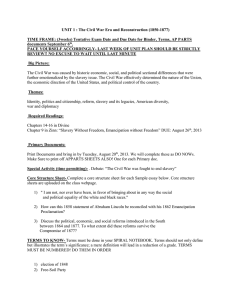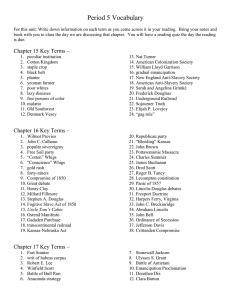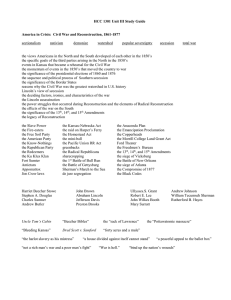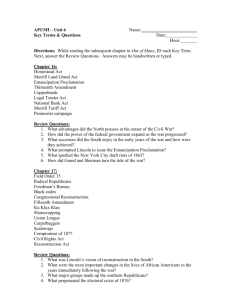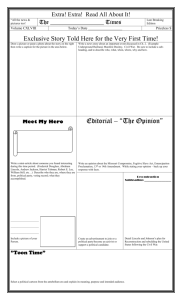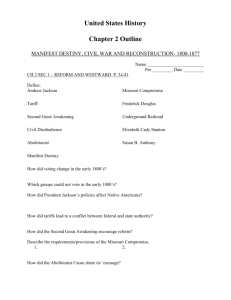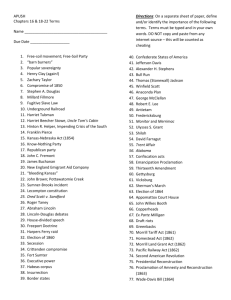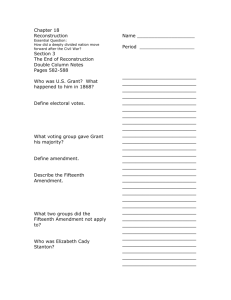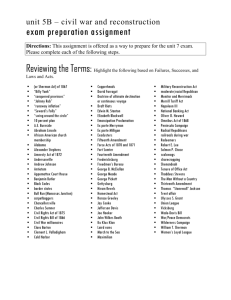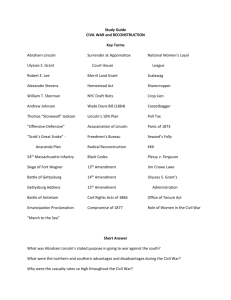UNIT 6: The Civil War Era and Reconstruction (1850
advertisement
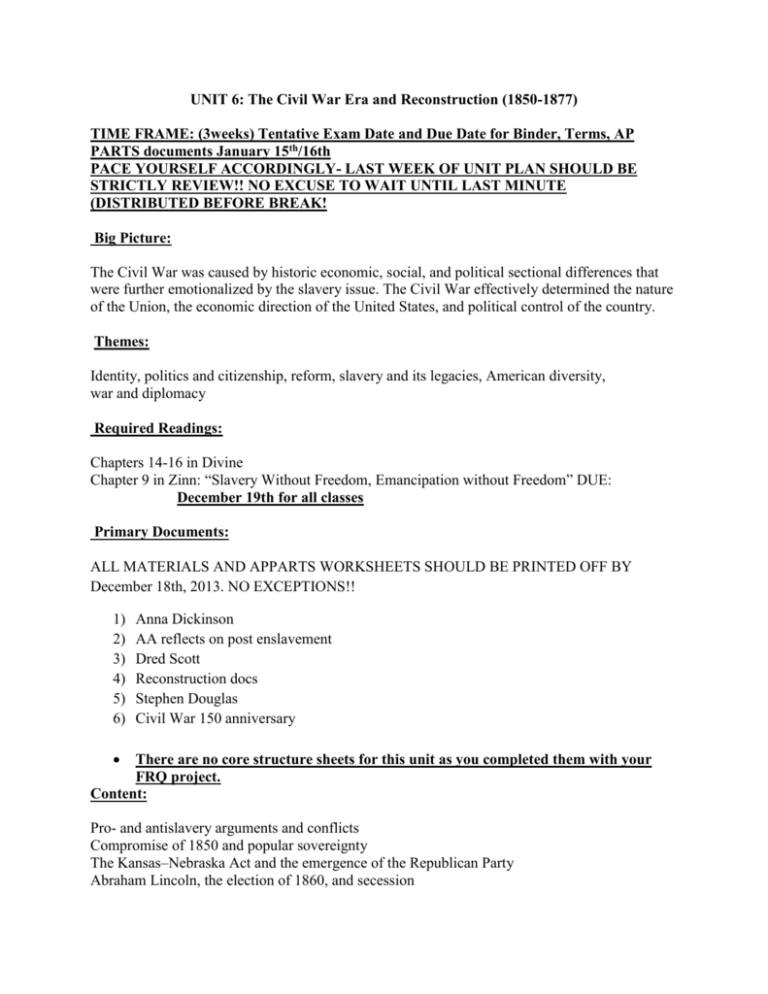
UNIT 6: The Civil War Era and Reconstruction (1850-1877) TIME FRAME: (3weeks) Tentative Exam Date and Due Date for Binder, Terms, AP PARTS documents January 15th/16th PACE YOURSELF ACCORDINGLY- LAST WEEK OF UNIT PLAN SHOULD BE STRICTLY REVIEW!! NO EXCUSE TO WAIT UNTIL LAST MINUTE (DISTRIBUTED BEFORE BREAK! Big Picture: The Civil War was caused by historic economic, social, and political sectional differences that were further emotionalized by the slavery issue. The Civil War effectively determined the nature of the Union, the economic direction of the United States, and political control of the country. Themes: Identity, politics and citizenship, reform, slavery and its legacies, American diversity, war and diplomacy Required Readings: Chapters 14-16 in Divine Chapter 9 in Zinn: “Slavery Without Freedom, Emancipation without Freedom” DUE: December 19th for all classes Primary Documents: ALL MATERIALS AND APPARTS WORKSHEETS SHOULD BE PRINTED OFF BY December 18th, 2013. NO EXCEPTIONS!! 1) 2) 3) 4) 5) 6) Anna Dickinson AA reflects on post enslavement Dred Scott Reconstruction docs Stephen Douglas Civil War 150 anniversary There are no core structure sheets for this unit as you completed them with your FRQ project. Content: Pro- and antislavery arguments and conflicts Compromise of 1850 and popular sovereignty The Kansas–Nebraska Act and the emergence of the Republican Party Abraham Lincoln, the election of 1860, and secession Two societies at war: mobilization, resources, and internal dissent Military strategies and foreign diplomacy Emancipation and the role of African Americans in the war Social, political, and economic effects of war in the North, South, and West Presidential and Radical Reconstruction Southern state governments: aspirations, achievements, failures Role of African Americans in politics, education, and the economy Compromise of 1877 Impact of Reconstruction Reconfiguration of southern agriculture: sharecropping and crop-lien system The politics of segregation: Jim Crow and disfranchisement Explain how sectionalism and the issues associated with it led to the Civil War. Identify social, political and economic changes that resulted from the Civil War and Reconstruction. Examine the economic, political and social status of African Americans during and immediately following Reconstruction. TERMS TO KNOW 1) election of 1848 2) Free-Soil Party 3) President Zachary Taylor 4) California Gold Rush 5) Underground Railroad 6) Harriet Tubman 7) Prigg v. Pennsylvania 8) “personal liberty laws” 9) Compromise of 1850 10) Henry Clay 11) William H. Seward 12) Fugitive Slave Law 13) Ableman v. Booth 14) President Millard Fillmore 15) Stephen Douglas 16) President Franklin Pierce 17) “Young America” 18) Commodore Matthew Perry 19) Ostend Manifesto 20) Gadsden Purchase 21) Kansas-Nebraska Act 22) Republican Party 23) Harriet Beecher Stowe, Uncle Tom’s Cabin 24) Hinton Helper, Impending Crisis of the South 25) “Beecher’s Bibles” 26) 27) 28) 29) 30) 31) 32) 33) 34) 35) 36) 37) 38) 39) 40) 41) 42) 43) 44) 45) 46) 47) 48) 49) 50) 51) 52) 53) 54) 55) 56) 57) 58) 59) 60) 61) 62) 63) 64) 65) 66) 67) sack of Lawrence, Kansas caning of Charles Sumner Preston Brooks John Brown Pottowatomie Massacre Lecompton Constitution “vote early and vote often” President James Buchanan “Know Nothings” (American Party) Dred Scott case Roger B. Taney Panic of 1857 Lincoln-Douglas debates Freeport Doctrine Harper’s Ferry election of 1860 Constitutional Union Party Abraham Lincoln South Carolina, secession Confederate States of America Jefferson Davis Crittenden amendments President Abraham Lincoln First Inaugural Address William H. Seward Salmon P. Chase Edwin M. Stanton Ft. Sumter, April 12, 1861 Lincoln’s call for volunteers secession of Middle South Border Slave States Robert E. Lee Thomas “Stonewall” Jackson Confederate States of America Jefferson Davis Trent Affair C.S.S. Alabama Charles Francis Adams Laird rams Maximilian, Emperor of Mexico federal conscription laws New York Draft Riot 68) 69) 70) 71) 72) 73) 74) 75) 76) 77) 78) 79) 80) 81) 82) 83) 84) 85) 86) 87) 88) 89) 90) 91) 92) 93) 94) 95) 96) 97) 98) 99) 100) 101) 102) 103) 104) 105) 106) 107) 108) 109) 110) 111) 112) 113) 114) African American soldiers Morrill Tariff Greenbacks National Banking System Homestead Act Morrill Land Grant Act Pacific Railway Act Union blockade Ex Parte Merryman, habeas corpus Anaconda Plan Battle of Bull Run “Stonewall” Jackson George McClellan Peninsula Campaign Robert E. Lee Battle of Antietam Emancipation Proclamation Confiscation Acts Ulysses S. Grant Battle of Shiloh Battle of Gettysburg Gettysburg Address Vicksburg William T. Sherman “March to the Sea” “Copperheads” Clement Vallandigham election of 1864 National Union Party Second Inaugural speech Grant’s Virginia Campaign Appomattox Court House John Wilkes Booth Mathew Brady Thirteenth Amendment Freedmen’s Bureau Gen. Oliver Howard President Andrew Johnson Presidential Reconstruction “10% Plan” Wade-Davis Bill Black Codes Congressional Reconstruction Civil Rights Bill of 1866 Fourteenth Amendment Radical Republicans Charles Sumner 115) 116) 117) 118) 119) 120) 121) 122) 123) 124) 125) 126) 127) 128) 129) 130) 131) 132) 133) 134) 135) 136) 137) 138) 139) 140) 141) 142) 143) 144) 145) 146) 147) 148) 149) 150) 151) 152) 153) 154) Thaddeus Stephens Moderate Republicans Military Reconstruction Act impeachment of Johnson Fifteenth Amendment Hiram R. Revels Blanche K. Bruce “Scalawags” “Carpetbaggers” Ku Klux Klan (KKK) Force Acts (Enforcement Acts) “Solid South” “Lost Cause” “Redeemers” “Bourbons” Civil Rights Act of 1875 Compromise of 1877 President Rutherford B. Hayes Ex Parte Milligan, 1866 sharecropping crop lien laws “Slaughterhouse” cases “Civil Rights” cases poll taxes literacy tests “grandfather” clauses gerrymandering “Jim Crow” laws lynching Ida B. Wells-Barnett Booker T. Washington Tuskegee Institute “accommodation” “Atlanta Compromise” Plessy v. Ferguson, 1896 “separate but equal” W. E. B. Du Bois Niagara Movement “talented tenth” NAACP
